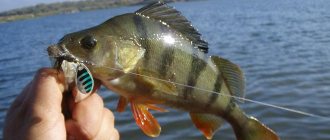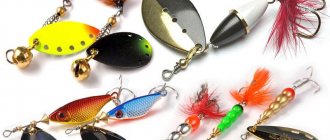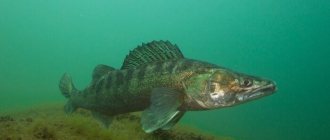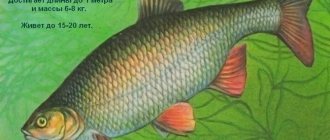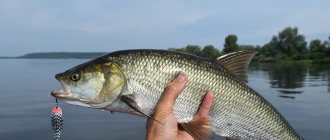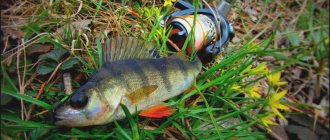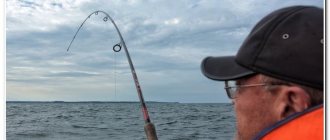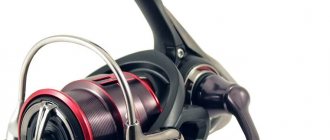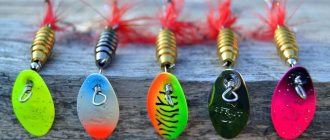Choosing catchable places
Bream prefers to be near the bottom, where it is rocky, there are a lot of shells, and there are thickets of algae.
From time to time it swims to areas with muddy and sandy bottoms, apparently for the purpose of a promenade. It doesn’t matter to bream what layer of water will be above it: 1.5 meters or 8. The main thing is that the water is not stagnant, fresh, with springs .
Where there are underground springs, the food floats on the border of cold and warm water, without sinking to the bottom (about 30 cm from it). Therefore, bream in such places is not caught on the bottom.
In August, mud will help determine the location of bream. August is the month of active growth of this aquatic plant, and it contains a lot of insects and worms, i.e. food for non-predatory fish.
Wiring
It is no different from a banal jig step, the only difference is the pause between reelings. The longer we pause, the better. The bait, hovering and sinking to the bottom, imitates a bug or worm that has been torn off the bottom by the current and carried away. The bream, not seeing the catch, swallows the bait to the very gills. After the bait reaches the bottom, we do not rush to tear it off with the reel, but begin to play with the tip of the rod, causing the bait to wriggle with its whole body, raising clouds of turbidity. Our bait should imitate bottom living creatures trying to quickly burrow into the bottom sediments, but they can’t do this due to injury or the density of the soil. This is where she becomes a victim of seasoned bream. A gentle “knock” and a small tremor are clearly transmitted into your hand, strongly reminiscent of a perch chewing bait when fishing with a retractable leash. It’s worth giving a second pause and making a short wrist hook, getting ready to immediately loosen the reel’s clutch, because after hooking, in a second or two there will be a powerful jerk to the side. You don't need to cut as hard as you can - the lips of a bream are soft and fleshy, but they are easily torn and cut with thin hooks, and hooking with a brush will be just right.
An interesting method of animation is dragging along the bottom, but it is only possible in clean places - clay or sand; on stones we get an instant hook. You shouldn’t write off the various swaying motions when the bait falls, or tearing off the bait with a fishing rod and then following it to the bottom with the tip of the spinning rod. There are many variations, and not every day the same bait and, accordingly, its animation work.

In the end, I would like to say that there is no point in releasing caught and pulled out bream - remember, it was said above that when a bream bites, it swallows the bait up to the gills? The hook, digging into the tissue of the oral cavity, causes irreparable damage, and the fish, even if released back, is unlikely to survive. Therefore, it is better, after catching a couple or three good bream, just find the strength in yourself and leave this point, or switch to another type of bait and fishing, for example, to catch pike perch or pike perch, which always graze next to schools of bream. Don’t try to knock out the whole flock - bream, after the disappearance of their comrades, begin to be more cautious about everything new, and cases of purple bream occur more and more often, and given that our hooks are weak, the cords are thin, then it is possible to pull out a purple bream weighing 3 kg It doesn't always work out. Have respect for yourself, first of all, and for nature, and your found point will delight you with bites and large bream on a spinning rod almost always.
Dmitry Pankratov.
Spinning and equipment
The most suitable spinning rod for catching bream is light or even ultralight . It is important that the rod can withstand the jerks of large fish. A spinning rod is suitable for catching bass (American perch) or large trout.
Requirements that a spinning rod for bream must meet:
- Lightness and sensitivity;
- The test corresponds to the weight of the bait (no more than 15 - 25 grams);
- Length that is not a problem during wiring;
- Lack of fish hatching due to lip rupture.
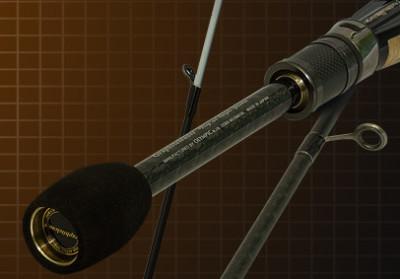
A good choice is carbon fiber spinning rods:
- Finezza (Graphiteleader);
- Belezza (Graphiteleader);
- Tiro (Graphiteleader);
- KGLights (Major Craft);
- Pontoon 21;
- St. Croix;
- Daiko;
- Nemesis (Encore);
- Rein's;
- Black Hole The One (Korea).
How and what to equip?
In general, the correct way to set up the spinning rod is as follows:
If the current is strong, the rig is done like this : a sinker is attached to a fishing line (monofilament or braided), and a 0.3 meter fluorocarbon leash (Seaguar, for example) with a spinner is attached above. The leash can also be steel: pike also bite on the lure.
You need a lightweight reel with a smooth ride and a friction brake. Shimano, Daiwa, and also Pflueger - if we talk about manufacturers of reels suitable for bream fishing.
We recommend using a microjig line (Daiwa, Sunline, Varivas) to rig a spinning rod for bream.
S. Shatalov: With a spinning rod for bream
In open water on the Ob, spinners catch mainly pike perch, pike perch, occasionally pike (there are few of them in the Novosibirsk region), in mid-summer - ide, and sometimes with very small spoons - dace. And in early July, to the surprise of many anglers, bream takes the lure.
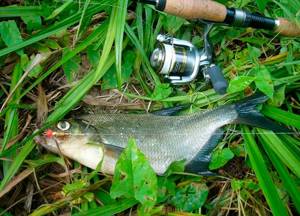
There is something to be surprised about - after all, a certain stereotype has developed about bream: this fish is peaceful, and it seems that it is not customary to catch it with bait intended for predators.
Let's turn to the literature. L.P. Sabaneev in “Life and Fishing of Freshwater Fishes” wrote: “It seems that the bream sometimes takes a lamprey larva as a squeak, but probably only by chance, since its predatory inclinations are very doubtful, as well as what it takes sometimes they’ll frog.” G.V. Nikolsky in “Ecology of Fish” and in “Particular Ichthyology” noted that the division of fish into peaceful and predatory “is very arbitrary, since most fish feed on mixed food.” A.P. Chekhov, a passionate and observant angler, wrote, not without irony: “The bream pretends to eat lean food. Having eaten the fish, he quickly wipes his mouth so that the “gentlemen” do not notice.”
Over the past four years, I have managed to catch more than two hundred bream using a spoon. I think my experience will be of interest to the readers of our magazine.
Lures for catching bream using a spinning rod
- Silicone tips . Especially edible rubber in the form of worms, snails, larvae, fish with narrow bodies, leeches (less than 9 cm). To taste, the bream smells of shrimp, garlic (fried), anise flavor. Suitable baits include Leech (Kota!), Ecogear, Rein's and Megabass , but you can experiment with others. For example, Keitech and Lunker City baits are combined with jig heads.
- Spinner spinners . To catch bream you need a number 1, 2 or 3 spinner. The bait should have a long narrow petal.
- Small jig baits with protection against snagging are convenient for fishing in thickets: Reins Platoon (up to 3.5 grams), nozzles made by Keitech (up to 2.6 grams).
Lures for fishing bream with a spinning rod
To catch bream we will use edible silicone baits. They are saturated with odorous attractants. It is better to use worms, slugs and crustaceans in light colors. Some of the best flavors for catching bream include shrimp, anise, garlic and vanilla.
Silicones should have a soft body and be as similar as possible to leeches and worms. The colors of the baits can be any: from black to light turquoise. In general, baits should naturally imitate insects with their movements. Modern silicones demonstrate an attractive game. Therefore, no special wiring technique is required.
As for installation, we will use a hinged one. It will allow the bream to absorb the bait, and it will not suspect anything is wrong. Jig heads are used when fishing at very shallow depths together with crustaceans and silicone bugs.
Conditions for a successful bite
Frequent bites of bream, if the place is chosen correctly, are observed in the heat in reservoirs with underground water flow. Cold water, 6 degrees, attracts fish if the average temperature in the reservoir is about 25 degrees , and the bream is at the bottom (25 - 30 cm from it), where it feeds on prey, which is driven here by the water current.
- Have you ever thought about spinning fishing for perch? Reading this article
- If you like Chekhon, then come here
- But you can’t ignore asp fishing with a spinning rod. Interesting and sporting activity
Technique and methods. How to fish with a spinning rod?
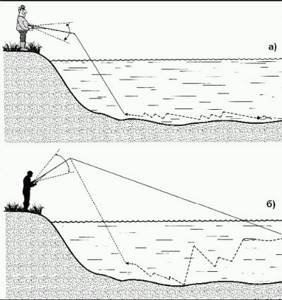
It is better to do wiring with pauses. The bait floating and sinking to the bottom should resemble the movements of a worm torn from the bottom by the current.
When the nozzle touches the bottom, we do not immediately lift it with a reel , but play with the tip of the spinning rod so that the “worm,” muddying the water, wriggles, as if trying to burrow into the sediment at the bottom. This is suitable prey for bream.
When biting, the fisherman feels the touch of the fish on the bait transmitted to his hand. There is a slight twitching sensation, similar to the bite of a perch when it chews a bait attached to a leash: the bream holds the “prey” in its mouth for a long time, without swallowing it and hovering in one place. After a second, we make a sweep, using only the hand.
In this case, you need to be prepared for an instant weakening of the reel brake: the hook is followed by a very strong jerk of the fish trying to free itself. A more powerful hook will not work, because the bream has very soft lips, and the hook breaks them. In addition, you can simply pull the bait out of the fish’s mouth, and the bream will swim away as if nothing had happened : it “thinks” for a long time before swallowing large prey.
Where to catch: habitats
Bream preferentially stick to the sandy bottom, in deep places. Fish of this species look for cooler areas, near springs and deep holes. In the mornings they go out to feed, for which they come closer to the shore. Bream linger the longest on shores shaded by tall trees.
We suggest you read: Fishing for pike with a spinning rod - search, gear, seasonal features
On small rivers, individuals often appear in the morning near tall aquatic vegetation, while the rest of the time they stay near deep pools and holes.
To hope for success in spinning fishing, it is important to find places where bream congregate. Only with high competition will the fish confidently attack a passing bait.
- Bream prefers to stay in areas of the reservoir with a rocky or pebble bottom. The flock can also linger on the shell rock. The depth at the fishing point can vary from 1 to 8 m. The presence of a current is very important for a good bite; only small bream can be caught in still water.
- Schools of fish like to stand on sandy, muddy and clay bottoms, but bream rarely feeds in such places. Most often, fish simply rest in such water areas.
- Large bream are best attracted by a combination of large stones, shell deposits and aquatic vegetation. And in the summer heat, areas of a reservoir with underwater springs or flowing streams become promising for fishing. The flock takes a position on the border of warm and cold water, where it picks up food.
- Water areas with large obstacles are successful for fishing. This could be an accumulation of boulders or snags that slow down the flow of the river. Below the obstacle, a hole is formed, at the bottom of which branches, shells and stones accumulate. Towards the end of summer there is an overgrowth of mud or thread-like vegetation. Insects and worms hide in it, attracting bream.
To catch bream using rubber or spoons, you need to correctly present the artificial bait. The feeding horizon of the fish and the degree of its activity should be taken into account.
There are several tactical approaches to which the appropriate wiring is selected.
- When fishing with rotating spoons, uniform wiring is used. Sometimes it can be varied by short jerks, changing the direction and speed of reeling. Turntables work well in the middle layers of water, when bream feeds at mid-water in the summer. Using spinners with petals, you can successfully hunt for fish in the spring in shallow water areas up to 2 m deep. You should start fishing with baits no more than 3 cm long, and if there are no bites, switch to smaller models. To arouse the interest of the bream, the threesome is camouflaged using white cambric and a bunch of red threads.
- Silicone fish expand the technical capabilities of the fisherman. Beginner spinning fishermen can animate baits using uniform wiring with various variations. Depending on the weight of the jig head, you can fish both shallows and deep holes. The method of dragging along the bottom on clean ground works well. On a rocky bottom, such wiring will lead to an instant hook.
- The jig technique for spinning bream fishing stands apart. It differs from the classic step, which is used when catching a predator. The difference lies in the length of the pause between windings of the fishing line. During a stop, the bait floats in a layer of water, imitating a worm or fry that is struggling with the current. The bream grabs the prey so greedily that the hook ends up in the fish's gills. Even when the bait sinks to the bottom, there is no need to rush to continue retrieving. At the moment of falling, a cloud of turbidity is formed, attracting the attention of the fish. The bream thinks that the prey is trying to burrow into the mud and sucks it in with its powerful mouth. At this moment, a light tapping and small trembling is transmitted to the fishing rod. After waiting a second, you need to make a short hook with your hand.
We suggest you read: Choosing effective equipment for catching pike perch
It is important! You should not hook the bream strongly and sweepingly, as the soft tissue of the oral cavity is easily torn. It is better to loosen the clutch to soften the hard kick.
Unfortunately, bream caught on a spinning rod can rarely be released back into the reservoir.
The catch-and-release principle cannot be implemented due to disruption of the gill tissues. Once injured by a hook, the fish will not be able to survive. In this regard, the fisherman’s “humanitarian brakes” should work. It is enough to catch 2-3 fish to finish fishing and thank the reservoir for the pleasure received.
Differences between fishing from the shore and from a boat
To catch bream using a spinning rod from the shore, choose rods that can be used to make long casts. An inertial reel and a leash longer than 1.5 meters are recommended .
For fishing from a boat, long casting is not required. The spinning rod used is lighter, and it can be equipped with a thinner cord than for fishing from the shore. A spinning reel and a leash up to 1.5 meters long are recommended .
Only large “peaceful” fish are caught with spinning rods. Spinning baits do not attract small things. An angler who has mastered the technique of catching non-predatory fish using a spinning rod and knows the habitats of bream will have a significant catch.
A short video about catching bream using a spinning rod on the Southern Bug River. Prepared by Ruslan Gramotin
Selection of basic equipment elements
Rod. It must be selected depending on the casting distance of the gear, and on the main features of the reservoir where fishing will take place. If we are talking about long casts (up to one hundred meters), then it is most effective to use carbon fiber. The length of the fishing rod ranges from 3.9 to 4.2 meters, the action is fast. In extreme cases, a 3.6 m stick is suitable, but throwing with this tackle requires some skill.
It is advisable to choose a test rod of 80-120 g, which will allow you to use heavy feeders. Each fisherman should have with him a certain supply of tips of varying degrees of hardness.
Feeder reel. To ensure that fishing with a feeder does not cause any trouble, the tackle must be equipped with a high-quality reel that will reel in the fishing line without any overlap. It is better to take low-profile spools, size 2500-3500 (for pickers and medium-class rods), and for fishing on currents and making long throws - 4000 or more.
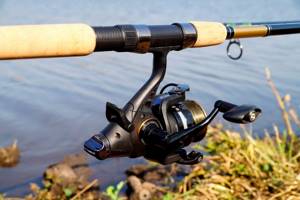
When using braided fishing line, the main elements of the reel must be made of titanium nitride. The reel needs to be balanced, and it is advisable to do this right in the store, taking the fishing rod with you.
Leash and fishing line. The main line requirements are strength and poor memory (so that it does not twist into rings). These requirements are best met by braided wire with a diameter of 0.10 – 0.12 mm. The thickness of the leash ranges from 0.16mm.
Feeders. They are the main element of the English donkey, and are selected depending on the amount of complementary foods and its weight. Much depends on where you will fish: whether it will be a fast river or a calm lake. It is advisable to take with you several options for feeders of different weights and sizes. For fishing on a calm or moderately flowing river, use triangular heavy feeders.

For long casts, weighty elements of equipment are suitable; in closed reservoirs, it is better to use round or oval models of feeders with large cells. But in this case their weight is significantly less (no more than 80g).
